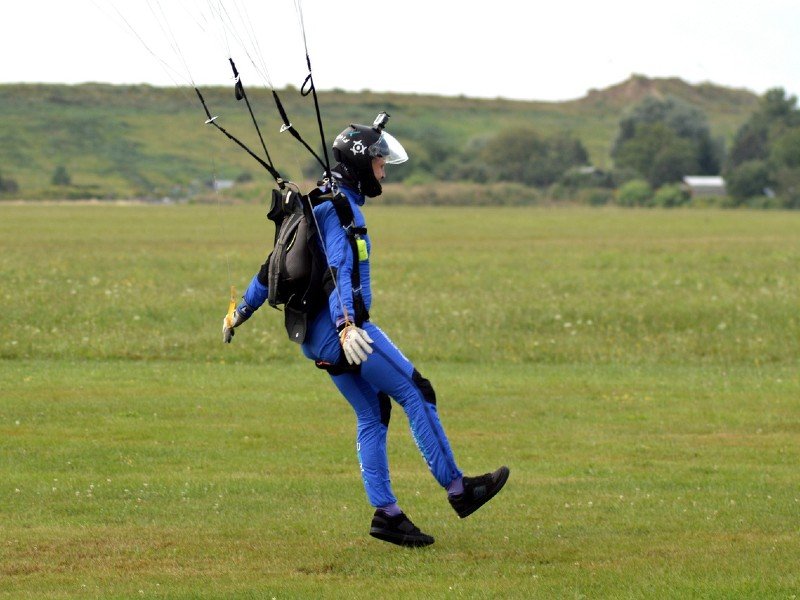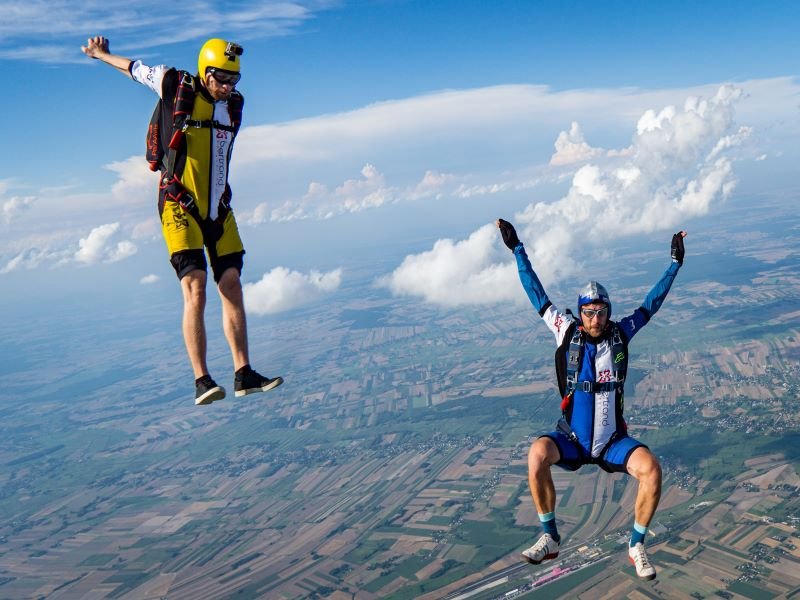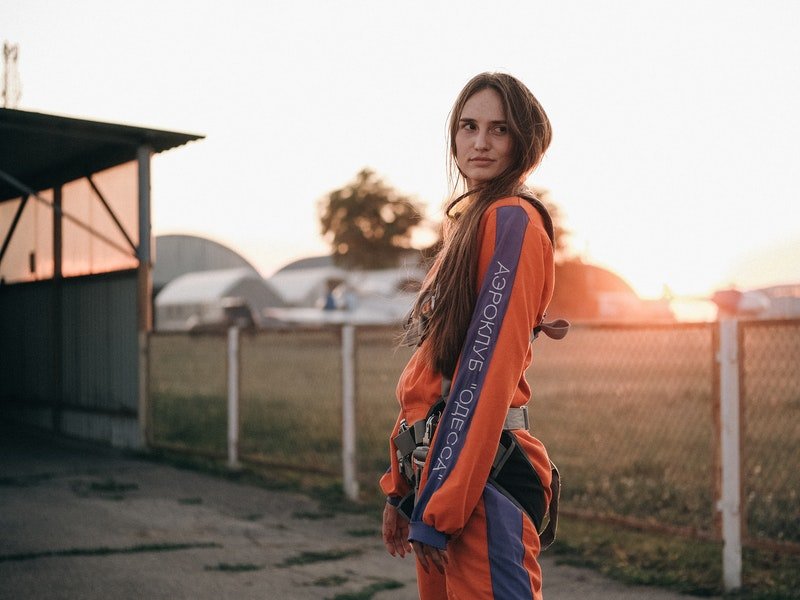Your jumpsuit will be one of the most important pieces of skydiving equipment. Choosing the right skydiving jumpsuit is not as simple as selecting the right style to fit your personality or finding the best color to bring out your eyes. Different types of jumpsuits perform better in different scenarios. And it makes a difference what your skydiving jumpsuit is made of.
From skin-type lycra suits to thick Cordura jumpsuits, the material you choose can make a difference to your skydiving experience. So it’s important to know what to expect and what to look for when selecting the right skydiving jumpsuit.
Let’s explore the world of skydiving jumpsuits and look at the different materials used and how they affect your diving. We will also highlight what to consider when buying your next jumpsuit and whether you need a jumpsuit at all.
What materials are skydiving jumpsuits made of?

There are many different types of materials and combinations of materials used to make skydiving jumpsuits. These materials primarily affect your skydiving in three ways: weight, drag, and comfort. The weight of your suit and the amount of drag will make a difference to how fast you freefall. The comfort will depend on the flexibility and thickness of the suit and how suitable it is for different temperatures.
It can get a bit confusing as many jumpsuit manufacturers create their own mixes of different fabrics. They often give many of these materials their own patented name. So while you may see many sites having materials with unique and unusual names, they are usually composites of the three core skydiving materials: nylon, polyester, and polycotton.
One of the heaviest materials with the most drag is Cordura. It’s a synthetic fiber-based fabric usually classed as nylon. It’s extremely strong and durable and often used to make suitcases and backpacks. Cordura skydiving suits will offer a lot of drag due to their bagginess. It’s a good option for those wanting a suit that slows you down. Due to the thickness of Cordura, it can be a bit stiff for some skydivers. Cordura is not ideal for jumping in hot weather.
Lycra and Taslan (polyester-based) offer much smoother and lighter suits on the opposite end of the scale to Cordura. These often skin-tight materials are incredibly lightweight and similar to those used by cyclists and other professional sports, where lightweight streamlining material is essential. Offering next-to-no drag, skydiving jumpsuits made from these materials help create greater freefall speeds but can often make it more difficult to control your dive. They can be too cold for wintery weather and maybe too fast for heavier skydivers.
How do different materials affect your skydive?

When opting for a fast and slick skydiving jumpsuit, Supplex, Taslan, Lycra, and Spandex are the most popular materials. These are highly flexible materials that have a very slim and tight fit, giving very little air resistance, allowing you to fall more rapidly and achieve higher terminal velocity. Creating a much sleeker streamline to your body will make it more difficult to control your dive. Flexibility can be a good thing. But too much flexibility in your jumpsuit can negatively affect you, especially if you are still ara a learner. We wouldn’t recommend these suits if you are a beginner or plan to jump in cold weather.
In more durable skydiving jumpsuits, the most common materials are Cordura and Ballistic Nylon. These materials offer many pros and cons, so it depends on your needs as to whether such suits are of good value. If well cared for, a Ballistic Nylon suit can easily last 10+ years, jumping 100 times per year.. They are thick and warm, and unlike Supplex and Lycra, they easily allow for more layers underneath. They also offer protection against any knocks and line burns. On the downside, they can be too thick and heavy for the hot seasons. And while they do offer lots of drag, the heavyweight materials can be too heavy to an already heavy skydiver.
The suits which offer the most comfort tend to be somewhere in the middle, having reasonably durable materials which provide some bagginess and drag, but without the weight and stiffness. Such materials include Taffeta and Taslan. These fabrics are strong but also reasonably light when compared to heavier suits. They don’t offer the optimal speed or drag, but they are very versatile suits with excellent breathability and comfort.
Which jumpsuit should I get?

As a beginner’s course learner, it’s a good idea to stick to the suits supplied by your skydiving school or instructor. At the early stages of your skydiving journey, you are yet to discover your strengths and weaknesses and understand the types of skydives you enjoy the best and the disciplines you want to master. You are advised to stick with a jumpsuit which helps you achieve stability and control unless you are particularly heavy or light.
As you progress and are ready to purchase your own jumpsuits, you may be tempted to get a baggier suit, which offers more drag and control. Before opting for a jumpsuit with a lot of drag, consider whether you plan to be jumping with other skydivers. Wearing a suit with too much drag can slow down your freefall enough to make it challenging to keep up with others jumping with you. It would be best if you also considered whether you would be doing any indoor tunnel skydiving. If so, a baggy suit isn’t ideal.
As a first jumpsuit, we recommend a nylon-based suit that is tailor-fitted. As well as being very comfortable, it will also offer lots of flexibility and will be easy to clean. A nylon spandex hybrid suit would also be good, allowing you that extra flexibility and speed. Our favorite beginner jumpsuits have a versatile nylon body, with lighter material, such as spandex on the legs, arms, and back, and more protective material, such as Cordura, covering the elbows, knees, and buttock areas.
Do you have to wear a jumpsuit to go skydiving?

While you may not be required to wear a skydiving jumpsuit on a tandem skydive (although it’s still recommended), especially on a hot summer’s day, you will be required to wear one as a solo skydiver. The weather at altitude is probably a lot cooler than you think, especially when feeling at close to 120 MPH through the skies. Skydiving jumpsuits are specifically designed to hand;e possible weather extremes, as well as any scrapes and bumps you might get when landing.
An all-in-one jumpsuit also keeps you well tucked in and offers a controlled amount of drag. As you get more confident and start interacting with others in mid-air, creating formations and trying new moves, having a jumpsuit that offers you a consistent level of control and drag will be paramount.

